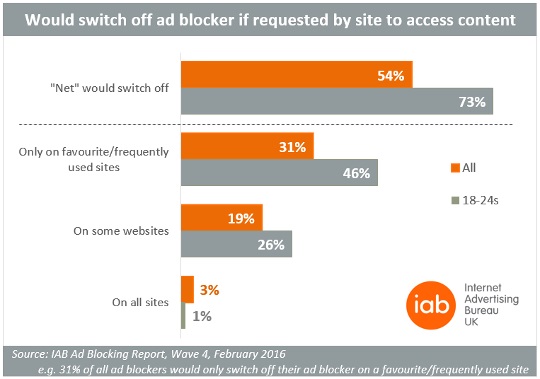Over two-fifths (22%) of British adults online are currently using ad blocking software – a rise from 18% in October, according to new research.

The latest wave of the Internet Advertising Bureau UK’s Ad Blocking Report, conducted online by YouGov, reveals that the highest level of ad blocking occurs amongst 18-24 year olds (47%), while 45-54 year olds are the least likely to block ads (16%), along with women (14%).
Key findings include:
⦁ Rise from 18% to 22% of British adults online using ad blockers
⦁ Over half using ad blocking software would turn it off to access content they want
Nearly two-thirds have been asked to turn blockers off
Nearly two-thirds (64%) of respondents who’ve downloaded the software have received a notice from a website asking them to turn off their ad blocker. Over half (54%) said, in certain situations, they would switch off their ad blocker if a website said it was the only way to access content – this rises to nearly three-quarters (73%) of 18-24 year olds.
Would switch off ad blocker if requested
One fifth (20%) of people who’ve downloaded an ad blocker no longer use it: not being able to access content they want being the second most popular reason for doing this, after changing to a new device.
“The IAB believes that an ad funded internet is essential for providing revenue to publishers so they can continue to make their content, services and applications widely available at little, or no cost,” said IAB UK’s CEO, Guy Phillipson. “We believe ad blocking undermines this approach and could mean consumers have to pay for content they currently get for free.”
He continues: “Part of the solution to tackle ad blocking lies in making consumers more aware of the consequences, which seems like it’s starting to filter through. If they realise it means they can’t access content or that to do so requires paying for it, then they might stop using ad blockers. It requires reinforcing this “trade-off” message – ads help to fund the content they enjoy for free.”
Less interference and fewer ads key ways to stop ad blocking
The most common reason people would be less likely to block ads is if they didn’t interfere with what they were doing (cited by 45%), followed by having fewer ads on a page (29%) and if they were more relevant (12%).
Phillipson concludes: “As an industry we are committed to improving the user experience with the LEAN ads programme launched last October, which promotes a less invasive, lighter ad experience.”
Among those currently using ad blocking software, 72% are doing so on laptops, 41% on desktop PCs, compared to 26% on smartphones and 21% on tablets.
Methodology
YouGov’s total sample size was 2,049 adults. The survey was conducted online during 19-22nd February 2016. The figures have been weighted and are representative of all GB adults (aged 18+). The previous wave was conducted 22-23rd October 2015, with a sample size of 2,052. The percentage of current ad blockers figure is calculated by asking if they have ever downloaded software on any of their personal devices that allows them to block adverts on the internet followed by a question to ascertain if they are a current user.
Source: www.iabuk.net
